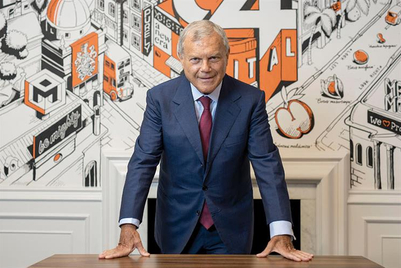
At 25, WPP is still characterised by the restlessness of its founder, Sir Martin Sorrell - and nowhere is this more apparent than in Asia-Pacific. The company is today arguably the most 'Asian' of the holding companies, dwarfing its nearest rival, Omnicom, thanks to Sorrell's relentless pursuit of growth in developing markets. Although noted in the west for his pessimism, Sorrell is eternally bullish on the network's prospects in this region.
"As the group was assembled, heavy investments were made in Asia where markets were growing fastest," observes Joseph L. Bower, Baker Foundation professor of business administration at Harvard Business School.
But Sorrell readily admits that luck has also played a major role in WPP's Asia success.
It all began with the purchase of JWT back in 1987, two years after the former Saatchi & Saatchi CFO had acquired the shopping basket maker Wire & Plastic Products, which would fittingly serve as a receptacle for his future acquisitions. The US$566 million purchase of the American giant (the first ever hostile takeover of an advertising agency) was not only a coup within the US; it also gave Sorrell a significant head start in Asia. Founded in 1864, JWT was one of the few networks with offices in the region, largely due to its relationship with Unilever: it had opened for business in China in 1986, and was already firmly established in India, Japan and Singapore.
Gaining momentum, Sorrell's company then acquired Ogilvy - in an equally hostile manner - for $864 million. Again, the agency had a footing in the region, having been operational in China since 1979, and India since 1928. By the end of the 1980s, WPP was itself an established presence in the East. In 1989, the same year as the Ogilvy takeover, WPP held its first board meeting, in China - an unusual move for a western firm at that time and indicative of what was to prove an enduring passion for the market from Sorrell.
Nonetheless, difficult times lay ahead. When the Gulf War caused advertising to plummet globally, so did WPP's stock price. In the early 1990s, the company was on the verge of bankruptcy. But it regained momentum, thanks in no small part to the relative buoyancy of its Asian operations, which were beginning to pay off.
In Hong Kong, two transplants from the West arrived: In 1994, Tom Doctoroff, now JWT's regional area director and Greater China CEO, came in from JWT Chicago as regional business director; the following year, Miles Young (pictured) arrived from Ogilvy & Mather Direct in London to take on the role of Asia-Pacific chairman.
A self-professed micro-manager, Sorrell uncharacteristically left his Asia-Pacific staff to their own devices. Young, who is widely tipped to become Sorrell's eventual successor, lists the milestones for Ogilvy in Asia: "We introduced the account planning discipline back in 1995. We brought in professional direct marketing. And we entered the new generation of developing markets such as Vietnam, Bangladesh, Pakistan, and Indonesia. That was 10 to 15 years ago. If you ask why WPP is twice the size of Omnicom, it is because of all of those things."
Indeed, Omnicom is only now weighing into markets like Bangladesh and Pakistan. But if any event foretold the direction of WPP today, it was the 1997 launch in Hong Kong of Mindshare - the merger of JWT's and Ogilvy's media departments into a single entity.
John Steedman (pictured), JWT's regional media director at the time and now GroupM's country head for Australia, recalls a feared "removal of income" among senior creative heads. But Asia set the stage for the agency's global roll-out, which, supported by Young and Alan Fairnington, then regional president of JWT, met with less resistance than in the UK and other western markets. The establishment marked a tipping point for WPP, which proceeded to acquire MEC, Mediacom and Maxus, eventually bundling them with Mindshare as GroupM.
The current $11 billion in media billings across Asia gives the network a market share of 38 per cent. Mindshare became the first media agency in Bangladesh in 2001, and the GroupM network has enabled WPP to step up activity in markets such as Vietnam, where it recently took a 30 per cent stake in three media companies-Datviet VAC Media, a media investment management agency; Dong Tay Promotions, a promotions and content agency; and TKL, a programming and media planning and buying operation.
In parallel to the establishment of GroupM, Sorrell also resumed his acquisitive streak on the creative agency side. With a fortified stock price, WPP strengthened its position in Japan with a 20 per cent stake in Asatsu-DK (ADK), the market's third largest agency. Sorrell describes the deal as one of his "most memorable", representing a major step forward in a notoriously difficult market.
The partnership later resulted in the opening of Mindshare Japan, among other joint ventures. WPP was also making inroads in Korea, having taken majority stakes in LG Ad (later renamed HS Ad) and in Diamond Ad through Ogilvy-although Young admits that market has been particularly challenging given the influence of chaebol conglomerates.
Regionally, few were surprised when WPP landed Young and Rubicam Group for $4.7 billion in 2000. Two years later, in 2003, the company bought Bates Worldwide, absorbing the bulk of its offices and spinning off an independent Asian network, Bates 141. This was followed by the 2005 purchase of Grey Global Group.
WPP's stable of above-the-line agencies was beginning to resemble its media buying side. The first major pitch under the new structure was for HSBC in 2004, which saw WPP leverage its strong profile in Asia to win against Omnicom. The pitch was the first in which Asia played a disproportionately larger role than the West, and alerted Omnicom to the need for greater investment in the region. "It wasn't until the HSBC pitch that I was struck by the power WPP offers," states Doctoroff.
Yet certain acquisitions have been more fruitful than others. The year 1997 also saw the purchase of Batey, which, though a landmark at the time, Sorrell admits was extremely difficult to bed down due to a clash of personality with founder Ian Batey (pictured), whom he describes as "one of the toughest characters I've met". Under WPP, the agency in 2007 lost its 35-year hold on Singapore Airlines, for which it had created the iconic 'Singapore Girl' decades before. In 2007 the carrier dropped all WPP agencies from its pitch roster in a public snub, later moving to Omnicom.
A year earlier, Omnicom also benefited from WPP's high profile split from Chinese agency Citic Guoan. Citic switched allegiance after a 14-year joint venture partnership with Grey after a row between Sorrell and vice-chairman Yan Gang, who publicly declared that the WPP boss had "no manners, upbringing or culture".
But despite the inevitable conflicts, Young says Sorrell appears much more at ease in Asia than his counterparts at rival
holding companies, and that he has put in the "long hours" needed to build strong relationships. Notably, he has served as something of an advisor to the Chinese Government, with WPP helping steer the state through the milk powder scandals and Darfur controversy of 2008. The company's localised approach in China gives it an edge over rivals, facilitating the long list of acquisitions made in recent years. These include marketing services company Star Echo, and digital firms HDT Holdings Technologies and Evision to name a few. Sorrell claims WPP is close to reaching its target of $1 billion in revenue across Greater China.
Unsurprisingly, India also remains a priority. The market contributed around 3.5 per cent to WPP's revenues last year, a figure Sorrell expects to rise to 5 per cent in 2010. The company holds a strong position in India thanks to Ogilvy and a recent joint venture deal between Mediacom and local agency Madison, which owns a 51 per cent stake in the GroupM shop. Sorrell states further India acquisitions are on the cards this year.
Meanwhile, across the region, Sorrell's commitment to below-the-line shows no sign of abating. In addition to the purchase of Taylor Nelson Sofres (TNS), the past few years have seen WPP spend more than $1 billion bolstering its digital line-up, which now includes leading Asian agency Agenda. The company was courted by both Publicis and Omnicom but elected to sell to WPP through Wunderman for a perceived higher level of independence. This enabled Wunderman to expand its Asian footprint by 40 per cent. The unbending pursuit of startups over the past decade has seen WPP's list of Asian companies develop into a marketer's Yellow Pages.
Looking back over a dramatic quarter of a century, Sorrell has one characteristic regret. "Did I think I would be sitting here with $14 billion in market cap?" he asks rhetorically. "The answer is no. But from a corporate point of view you always feel you didn't move quickly enough. If you have something good, you tend to think you should have got more of it."
Key events in Asia
1985 - Martin Sorrell buys a controlling stake in Wire & Plastic Products for $676,000
1987 - WPP makes advertising history with the hostile takeover of JWT for $566 million
1989 - WPP acquires Ogilvy Group for $864 million, a year after listing on the NASDAQ
1989 - WPP sells JWT property in Tokyo at the peak of the market for a record $205 million
1989 - First WPP board meeting held in China at the Pearl River Hotel in Guangzhou
1994 - Tom Doctoroff arrives from Chicago as regional business director for JWT
1995 - Miles Young is appointed chairman of Ogilvy & Mather Asia-Pacific
1997 - Mindshare launches in Hong Kong; WPP acquires 37 per cent stake in Batey Ads
1998 - WPP takes 20 per cent stake in Asatsu-DK, Japan's third-largest agency
2000 - WPP acquires Young & Rubicam Group for $4.6 billion
2003 - WPP acquires Cordiant; relaunches Bates as standalone Asian agency brand, Bates 141
2003 - GroupM is formed; WPP wins landmark global HSBC account in pitch against Omnicom
2005 - WPP acquires Grey Global Group
2006 - Citic Guoan splits from Grey and WPP in China after a 14-year partnership
2008 - WPP acquires Agenda, expanding Wunderman's Asia presences by 40 per cent
2009 - Ogilvy's Asia heads go global; Miles Young becomes CEO; Tham Khai Meng becomes creative director
Got a view?
Email [email protected]
This article was originally published in the 20 May 2010 issue of Media.




.jpg&h=334&w=500&q=100&v=20250320&c=1)
.jpg&h=334&w=500&q=100&v=20250320&c=1)



.jpg&h=334&w=500&q=100&v=20250320&c=1)
.png&h=334&w=500&q=100&v=20250320&c=1)




.jpg&h=268&w=401&q=100&v=20250320&c=1)
.jpg&h=268&w=401&q=100&v=20250320&c=1)


